Legal Analysis: Contract Law Case Study of Alan's Book Sales
VerifiedAdded on 2023/03/30
|9
|1805
|103
Case Study
AI Summary
This case study examines a contract law scenario involving Alan, who offered to sell a commercial law textbook to his friends. The analysis focuses on whether valid contracts were formed with Bernard, Charleen, and Damien, considering the elements of offer, acceptance, and potential misrepresentation. The study explores the legal positions and remedies available to each party, including rescission, damages, and specific performance. Additionally, it discusses alternative dispute resolution (ADR) mechanisms such as negotiation, mediation, and arbitration, evaluating their pros and cons in the context of Singapore's legal framework. Desklib offers more solved assignments and past papers for students.
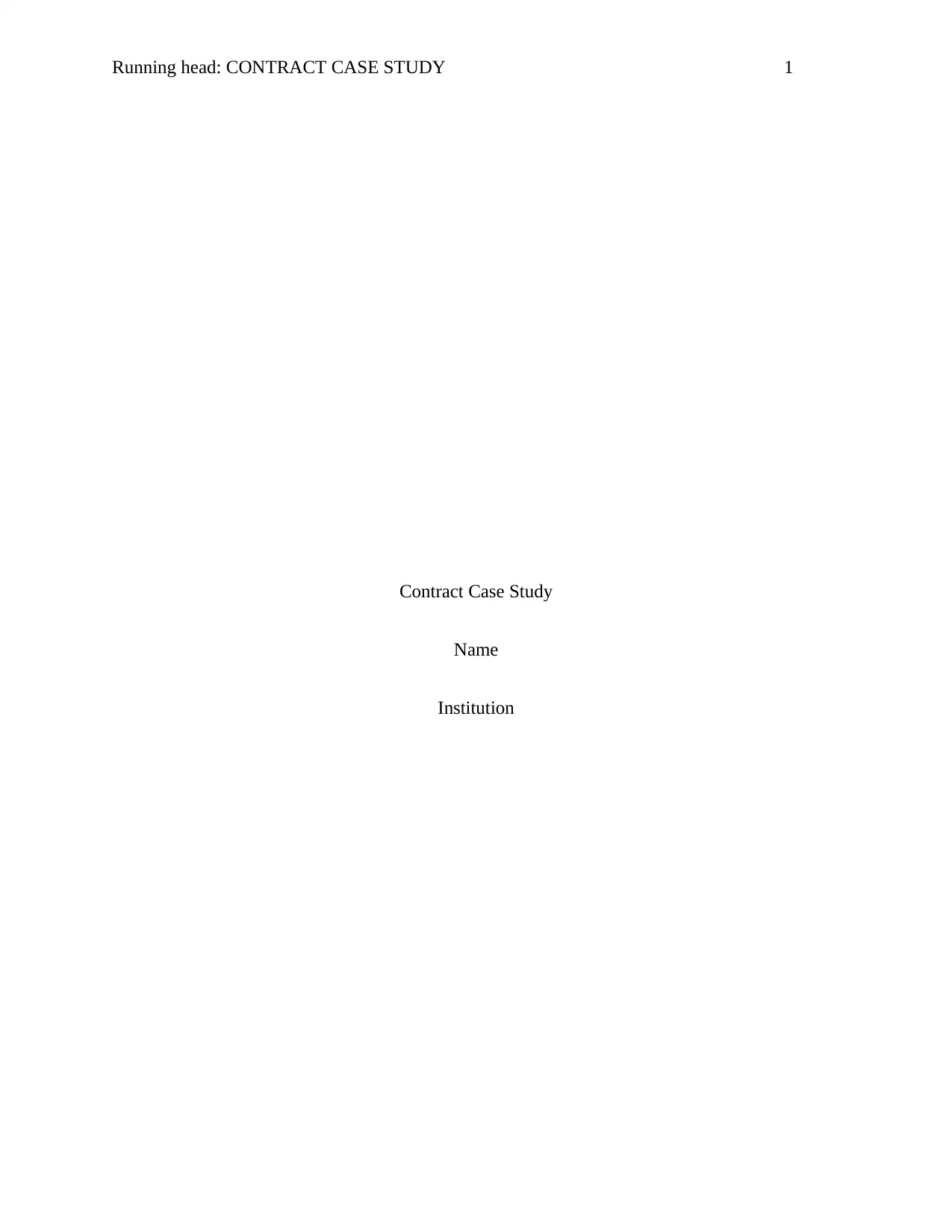
Running head: CONTRACT CASE STUDY 1
Contract Case Study
Name
Institution
Contract Case Study
Name
Institution
Paraphrase This Document
Need a fresh take? Get an instant paraphrase of this document with our AI Paraphraser
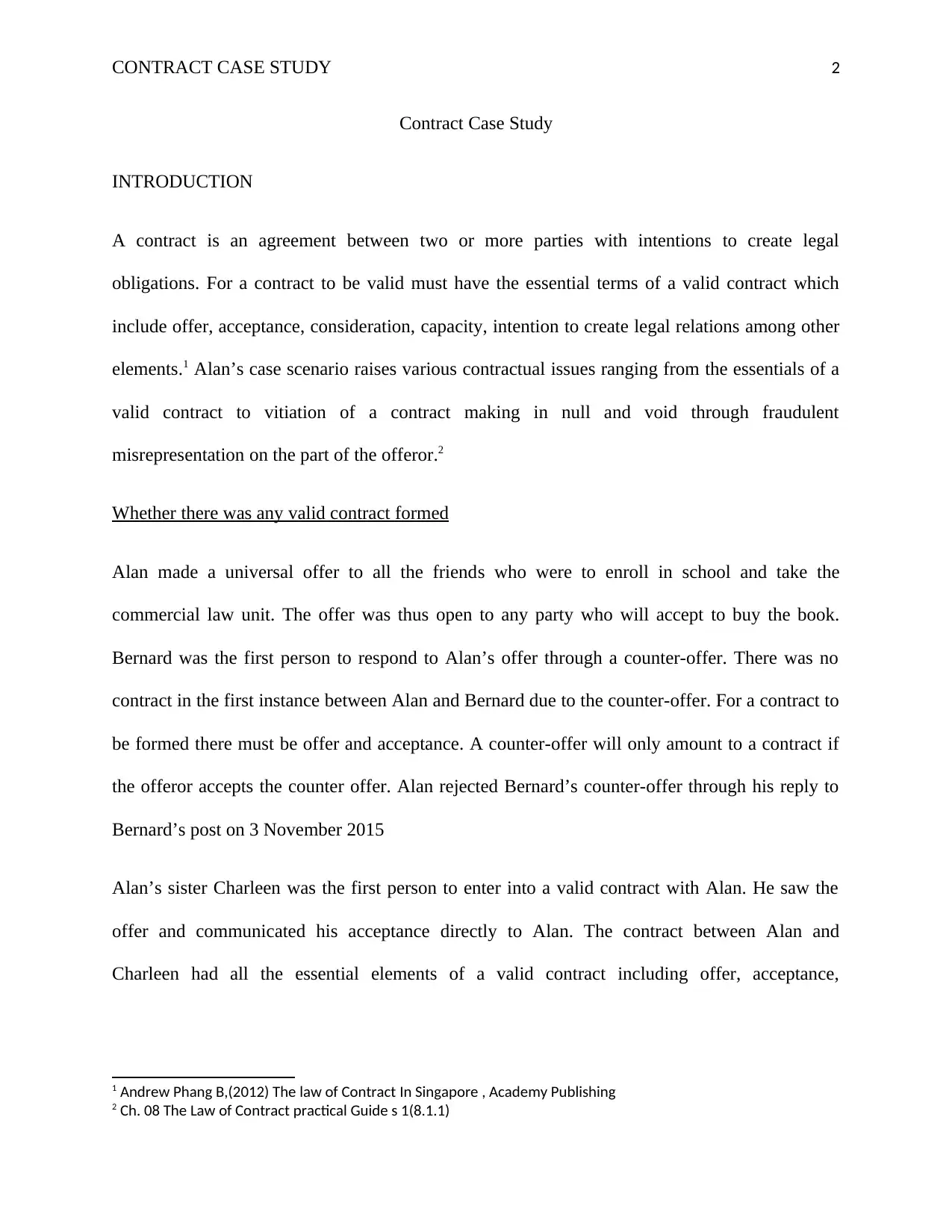
CONTRACT CASE STUDY 2
Contract Case Study
INTRODUCTION
A contract is an agreement between two or more parties with intentions to create legal
obligations. For a contract to be valid must have the essential terms of a valid contract which
include offer, acceptance, consideration, capacity, intention to create legal relations among other
elements.1 Alan’s case scenario raises various contractual issues ranging from the essentials of a
valid contract to vitiation of a contract making in null and void through fraudulent
misrepresentation on the part of the offeror.2
Whether there was any valid contract formed
Alan made a universal offer to all the friends who were to enroll in school and take the
commercial law unit. The offer was thus open to any party who will accept to buy the book.
Bernard was the first person to respond to Alan’s offer through a counter-offer. There was no
contract in the first instance between Alan and Bernard due to the counter-offer. For a contract to
be formed there must be offer and acceptance. A counter-offer will only amount to a contract if
the offeror accepts the counter offer. Alan rejected Bernard’s counter-offer through his reply to
Bernard’s post on 3 November 2015
Alan’s sister Charleen was the first person to enter into a valid contract with Alan. He saw the
offer and communicated his acceptance directly to Alan. The contract between Alan and
Charleen had all the essential elements of a valid contract including offer, acceptance,
1 Andrew Phang B,(2012) The law of Contract In Singapore , Academy Publishing
2 Ch. 08 The Law of Contract practical Guide s 1(8.1.1)
Contract Case Study
INTRODUCTION
A contract is an agreement between two or more parties with intentions to create legal
obligations. For a contract to be valid must have the essential terms of a valid contract which
include offer, acceptance, consideration, capacity, intention to create legal relations among other
elements.1 Alan’s case scenario raises various contractual issues ranging from the essentials of a
valid contract to vitiation of a contract making in null and void through fraudulent
misrepresentation on the part of the offeror.2
Whether there was any valid contract formed
Alan made a universal offer to all the friends who were to enroll in school and take the
commercial law unit. The offer was thus open to any party who will accept to buy the book.
Bernard was the first person to respond to Alan’s offer through a counter-offer. There was no
contract in the first instance between Alan and Bernard due to the counter-offer. For a contract to
be formed there must be offer and acceptance. A counter-offer will only amount to a contract if
the offeror accepts the counter offer. Alan rejected Bernard’s counter-offer through his reply to
Bernard’s post on 3 November 2015
Alan’s sister Charleen was the first person to enter into a valid contract with Alan. He saw the
offer and communicated his acceptance directly to Alan. The contract between Alan and
Charleen had all the essential elements of a valid contract including offer, acceptance,
1 Andrew Phang B,(2012) The law of Contract In Singapore , Academy Publishing
2 Ch. 08 The Law of Contract practical Guide s 1(8.1.1)
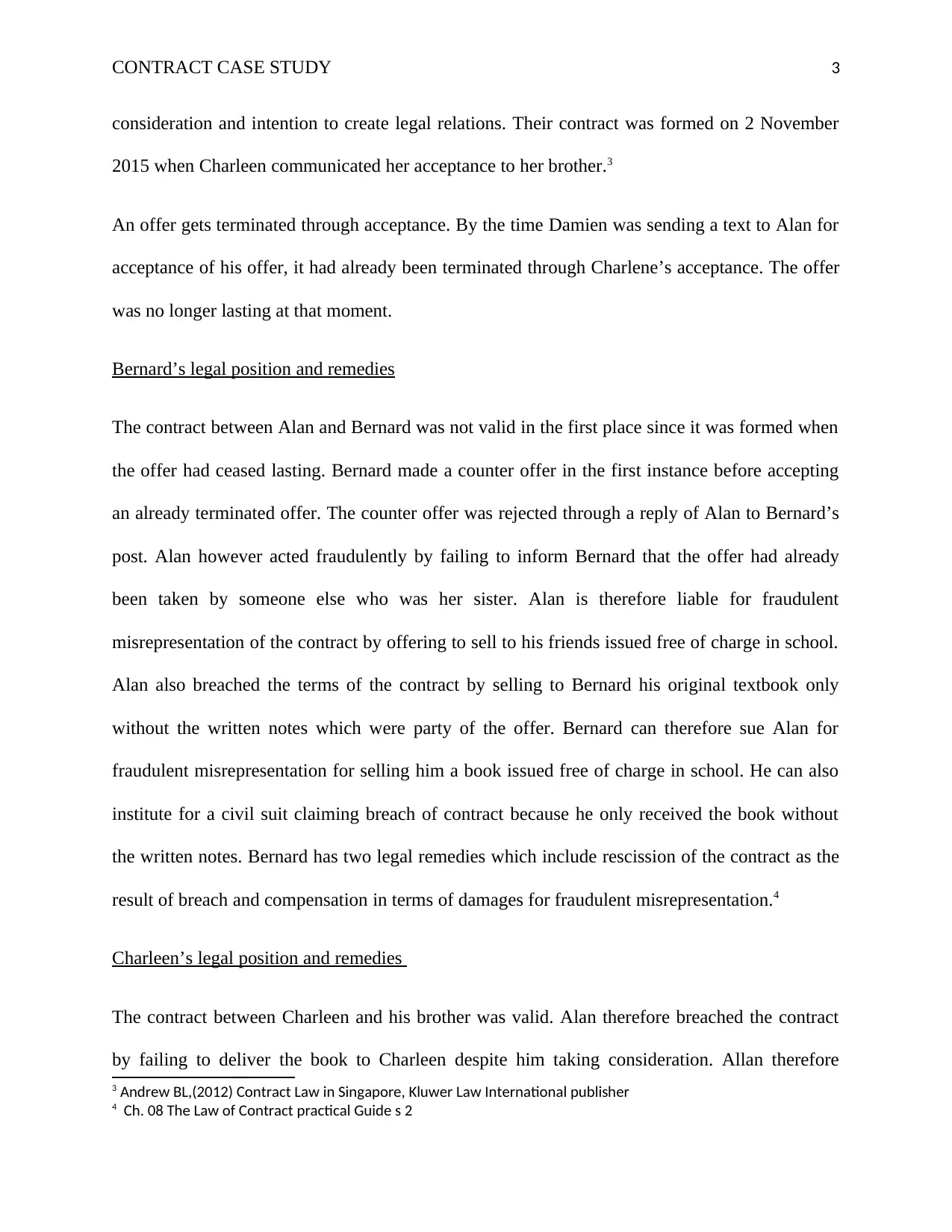
CONTRACT CASE STUDY 3
consideration and intention to create legal relations. Their contract was formed on 2 November
2015 when Charleen communicated her acceptance to her brother.3
An offer gets terminated through acceptance. By the time Damien was sending a text to Alan for
acceptance of his offer, it had already been terminated through Charlene’s acceptance. The offer
was no longer lasting at that moment.
Bernard’s legal position and remedies
The contract between Alan and Bernard was not valid in the first place since it was formed when
the offer had ceased lasting. Bernard made a counter offer in the first instance before accepting
an already terminated offer. The counter offer was rejected through a reply of Alan to Bernard’s
post. Alan however acted fraudulently by failing to inform Bernard that the offer had already
been taken by someone else who was her sister. Alan is therefore liable for fraudulent
misrepresentation of the contract by offering to sell to his friends issued free of charge in school.
Alan also breached the terms of the contract by selling to Bernard his original textbook only
without the written notes which were party of the offer. Bernard can therefore sue Alan for
fraudulent misrepresentation for selling him a book issued free of charge in school. He can also
institute for a civil suit claiming breach of contract because he only received the book without
the written notes. Bernard has two legal remedies which include rescission of the contract as the
result of breach and compensation in terms of damages for fraudulent misrepresentation.4
Charleen’s legal position and remedies
The contract between Charleen and his brother was valid. Alan therefore breached the contract
by failing to deliver the book to Charleen despite him taking consideration. Allan therefore
3 Andrew BL,(2012) Contract Law in Singapore, Kluwer Law International publisher
4 Ch. 08 The Law of Contract practical Guide s 2
consideration and intention to create legal relations. Their contract was formed on 2 November
2015 when Charleen communicated her acceptance to her brother.3
An offer gets terminated through acceptance. By the time Damien was sending a text to Alan for
acceptance of his offer, it had already been terminated through Charlene’s acceptance. The offer
was no longer lasting at that moment.
Bernard’s legal position and remedies
The contract between Alan and Bernard was not valid in the first place since it was formed when
the offer had ceased lasting. Bernard made a counter offer in the first instance before accepting
an already terminated offer. The counter offer was rejected through a reply of Alan to Bernard’s
post. Alan however acted fraudulently by failing to inform Bernard that the offer had already
been taken by someone else who was her sister. Alan is therefore liable for fraudulent
misrepresentation of the contract by offering to sell to his friends issued free of charge in school.
Alan also breached the terms of the contract by selling to Bernard his original textbook only
without the written notes which were party of the offer. Bernard can therefore sue Alan for
fraudulent misrepresentation for selling him a book issued free of charge in school. He can also
institute for a civil suit claiming breach of contract because he only received the book without
the written notes. Bernard has two legal remedies which include rescission of the contract as the
result of breach and compensation in terms of damages for fraudulent misrepresentation.4
Charleen’s legal position and remedies
The contract between Charleen and his brother was valid. Alan therefore breached the contract
by failing to deliver the book to Charleen despite him taking consideration. Allan therefore
3 Andrew BL,(2012) Contract Law in Singapore, Kluwer Law International publisher
4 Ch. 08 The Law of Contract practical Guide s 2
⊘ This is a preview!⊘
Do you want full access?
Subscribe today to unlock all pages.

Trusted by 1+ million students worldwide

CONTRACT CASE STUDY 4
committed a material breach. Charleen can institute a legal suit for breach of contract and claim
compensation in terms of damages for loss suffered due to material breach. Alternatively
Charleen could decide to repudiate the contract and claim refund of his money inform of
restitution from Bernard. Since the contract between Charleen and Alan was the only valid
contract formed, Charleen could decide to institute a suit seeking for an equitable remedy of
specific performance compelling Alan to give her the book and the notes as it was in the terms of
the contract.5
Damien’s legal position and remedies
Damien’s legal position is not much different from Bernard’s position since they were both
tricked to buy a free book issued at school free of charge the contract between Alan and Damien
was void abinitio since offer had already been terminated yet Alan proceeded to accept the
money from him. Damien can institute a suit for fraudulent misrepresentation seeking to rescind
the contract and get his money refunded by Alan on the grounds that the book sold was being
offered free charge in school and that the offer was not lasting at the time he made his acceptance
yet Alan failed to indicate so.6
Alternative dispute resolution (ADR) mechanisms available
Negotiation
It is an alternative form of settling disputes through compromising and making concessions until
parties settle at an amicable solution without arguing. For the above case scenario, the aggrieved
parties can decide to meet with Alan and negotiate the way out instead of going to litigation
which is tedious, costly and time consuming. The following are the pros and cons of negotiation;
5 Ch. 08 The Law of Contract Practical Guide s 3
6 Ch. 08 The Law of Contract practical Guide s 10(8.10.6)
committed a material breach. Charleen can institute a legal suit for breach of contract and claim
compensation in terms of damages for loss suffered due to material breach. Alternatively
Charleen could decide to repudiate the contract and claim refund of his money inform of
restitution from Bernard. Since the contract between Charleen and Alan was the only valid
contract formed, Charleen could decide to institute a suit seeking for an equitable remedy of
specific performance compelling Alan to give her the book and the notes as it was in the terms of
the contract.5
Damien’s legal position and remedies
Damien’s legal position is not much different from Bernard’s position since they were both
tricked to buy a free book issued at school free of charge the contract between Alan and Damien
was void abinitio since offer had already been terminated yet Alan proceeded to accept the
money from him. Damien can institute a suit for fraudulent misrepresentation seeking to rescind
the contract and get his money refunded by Alan on the grounds that the book sold was being
offered free charge in school and that the offer was not lasting at the time he made his acceptance
yet Alan failed to indicate so.6
Alternative dispute resolution (ADR) mechanisms available
Negotiation
It is an alternative form of settling disputes through compromising and making concessions until
parties settle at an amicable solution without arguing. For the above case scenario, the aggrieved
parties can decide to meet with Alan and negotiate the way out instead of going to litigation
which is tedious, costly and time consuming. The following are the pros and cons of negotiation;
5 Ch. 08 The Law of Contract Practical Guide s 3
6 Ch. 08 The Law of Contract practical Guide s 10(8.10.6)
Paraphrase This Document
Need a fresh take? Get an instant paraphrase of this document with our AI Paraphraser
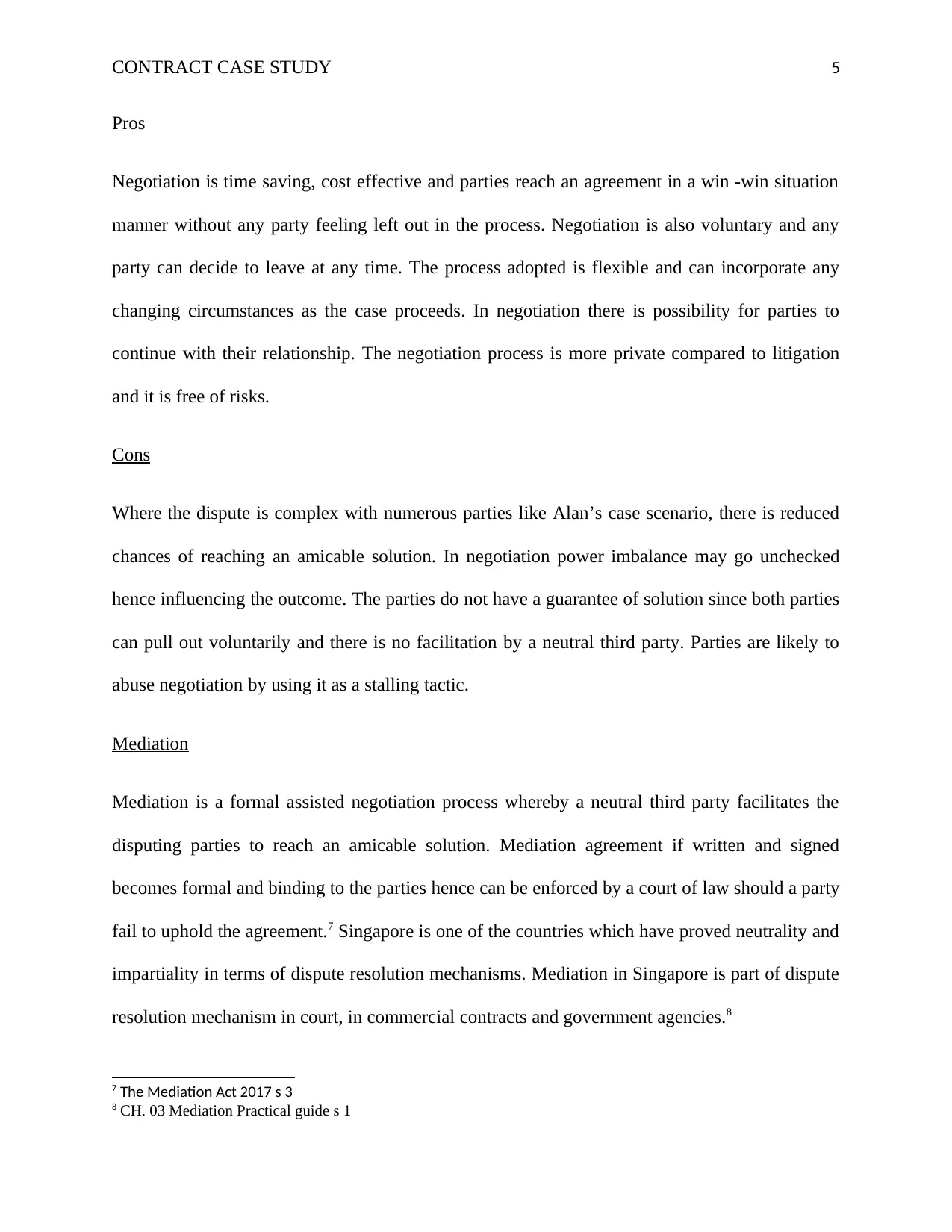
CONTRACT CASE STUDY 5
Pros
Negotiation is time saving, cost effective and parties reach an agreement in a win -win situation
manner without any party feeling left out in the process. Negotiation is also voluntary and any
party can decide to leave at any time. The process adopted is flexible and can incorporate any
changing circumstances as the case proceeds. In negotiation there is possibility for parties to
continue with their relationship. The negotiation process is more private compared to litigation
and it is free of risks.
Cons
Where the dispute is complex with numerous parties like Alan’s case scenario, there is reduced
chances of reaching an amicable solution. In negotiation power imbalance may go unchecked
hence influencing the outcome. The parties do not have a guarantee of solution since both parties
can pull out voluntarily and there is no facilitation by a neutral third party. Parties are likely to
abuse negotiation by using it as a stalling tactic.
Mediation
Mediation is a formal assisted negotiation process whereby a neutral third party facilitates the
disputing parties to reach an amicable solution. Mediation agreement if written and signed
becomes formal and binding to the parties hence can be enforced by a court of law should a party
fail to uphold the agreement.7 Singapore is one of the countries which have proved neutrality and
impartiality in terms of dispute resolution mechanisms. Mediation in Singapore is part of dispute
resolution mechanism in court, in commercial contracts and government agencies.8
7 The Mediation Act 2017 s 3
8 CH. 03 Mediation Practical guide s 1
Pros
Negotiation is time saving, cost effective and parties reach an agreement in a win -win situation
manner without any party feeling left out in the process. Negotiation is also voluntary and any
party can decide to leave at any time. The process adopted is flexible and can incorporate any
changing circumstances as the case proceeds. In negotiation there is possibility for parties to
continue with their relationship. The negotiation process is more private compared to litigation
and it is free of risks.
Cons
Where the dispute is complex with numerous parties like Alan’s case scenario, there is reduced
chances of reaching an amicable solution. In negotiation power imbalance may go unchecked
hence influencing the outcome. The parties do not have a guarantee of solution since both parties
can pull out voluntarily and there is no facilitation by a neutral third party. Parties are likely to
abuse negotiation by using it as a stalling tactic.
Mediation
Mediation is a formal assisted negotiation process whereby a neutral third party facilitates the
disputing parties to reach an amicable solution. Mediation agreement if written and signed
becomes formal and binding to the parties hence can be enforced by a court of law should a party
fail to uphold the agreement.7 Singapore is one of the countries which have proved neutrality and
impartiality in terms of dispute resolution mechanisms. Mediation in Singapore is part of dispute
resolution mechanism in court, in commercial contracts and government agencies.8
7 The Mediation Act 2017 s 3
8 CH. 03 Mediation Practical guide s 1
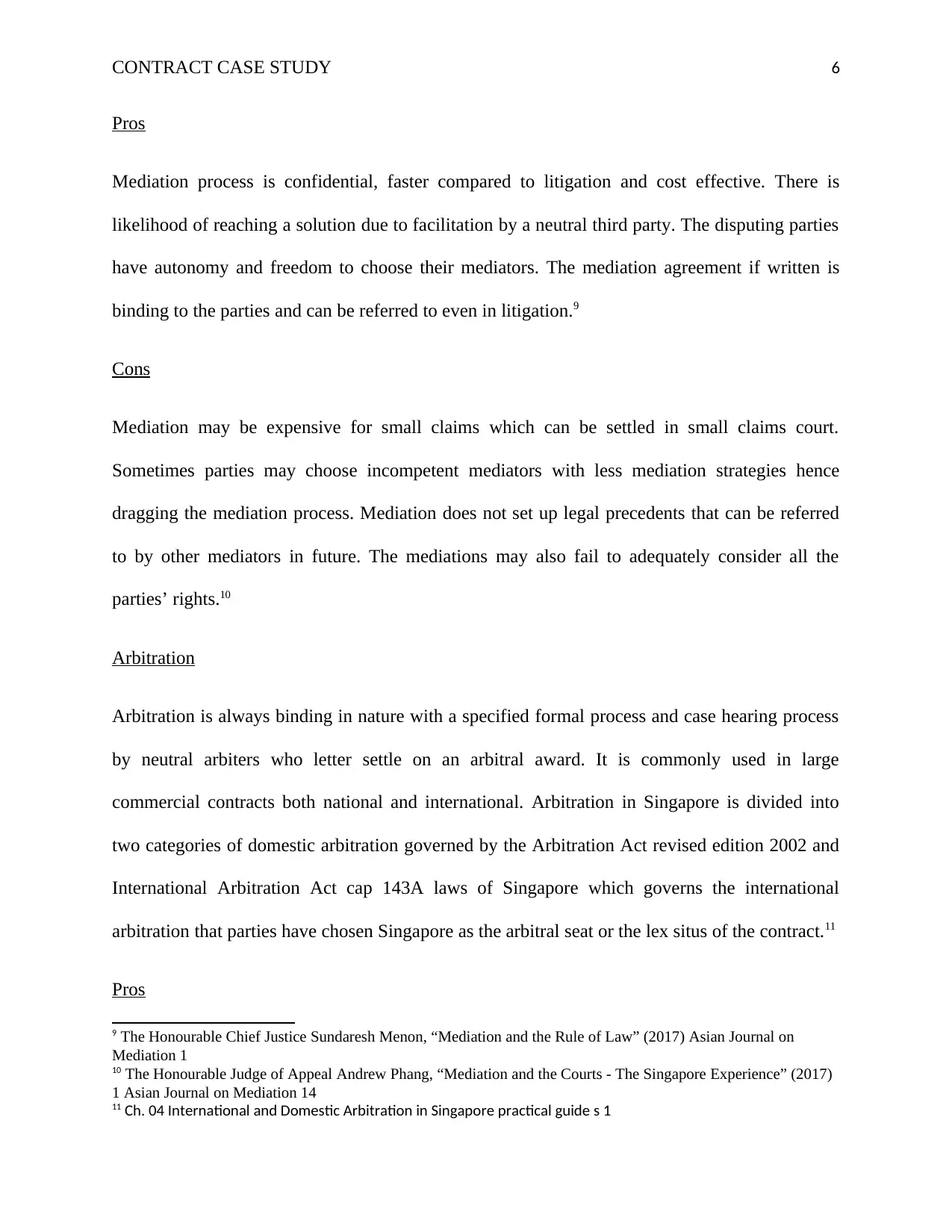
CONTRACT CASE STUDY 6
Pros
Mediation process is confidential, faster compared to litigation and cost effective. There is
likelihood of reaching a solution due to facilitation by a neutral third party. The disputing parties
have autonomy and freedom to choose their mediators. The mediation agreement if written is
binding to the parties and can be referred to even in litigation.9
Cons
Mediation may be expensive for small claims which can be settled in small claims court.
Sometimes parties may choose incompetent mediators with less mediation strategies hence
dragging the mediation process. Mediation does not set up legal precedents that can be referred
to by other mediators in future. The mediations may also fail to adequately consider all the
parties’ rights.10
Arbitration
Arbitration is always binding in nature with a specified formal process and case hearing process
by neutral arbiters who letter settle on an arbitral award. It is commonly used in large
commercial contracts both national and international. Arbitration in Singapore is divided into
two categories of domestic arbitration governed by the Arbitration Act revised edition 2002 and
International Arbitration Act cap 143A laws of Singapore which governs the international
arbitration that parties have chosen Singapore as the arbitral seat or the lex situs of the contract.11
Pros
9 The Honourable Chief Justice Sundaresh Menon, “Mediation and the Rule of Law” (2017) Asian Journal on
Mediation 1
10 The Honourable Judge of Appeal Andrew Phang, “Mediation and the Courts - The Singapore Experience” (2017)
1 Asian Journal on Mediation 14
11 Ch. 04 International and Domestic Arbitration in Singapore practical guide s 1
Pros
Mediation process is confidential, faster compared to litigation and cost effective. There is
likelihood of reaching a solution due to facilitation by a neutral third party. The disputing parties
have autonomy and freedom to choose their mediators. The mediation agreement if written is
binding to the parties and can be referred to even in litigation.9
Cons
Mediation may be expensive for small claims which can be settled in small claims court.
Sometimes parties may choose incompetent mediators with less mediation strategies hence
dragging the mediation process. Mediation does not set up legal precedents that can be referred
to by other mediators in future. The mediations may also fail to adequately consider all the
parties’ rights.10
Arbitration
Arbitration is always binding in nature with a specified formal process and case hearing process
by neutral arbiters who letter settle on an arbitral award. It is commonly used in large
commercial contracts both national and international. Arbitration in Singapore is divided into
two categories of domestic arbitration governed by the Arbitration Act revised edition 2002 and
International Arbitration Act cap 143A laws of Singapore which governs the international
arbitration that parties have chosen Singapore as the arbitral seat or the lex situs of the contract.11
Pros
9 The Honourable Chief Justice Sundaresh Menon, “Mediation and the Rule of Law” (2017) Asian Journal on
Mediation 1
10 The Honourable Judge of Appeal Andrew Phang, “Mediation and the Courts - The Singapore Experience” (2017)
1 Asian Journal on Mediation 14
11 Ch. 04 International and Domestic Arbitration in Singapore practical guide s 1
⊘ This is a preview!⊘
Do you want full access?
Subscribe today to unlock all pages.

Trusted by 1+ million students worldwide
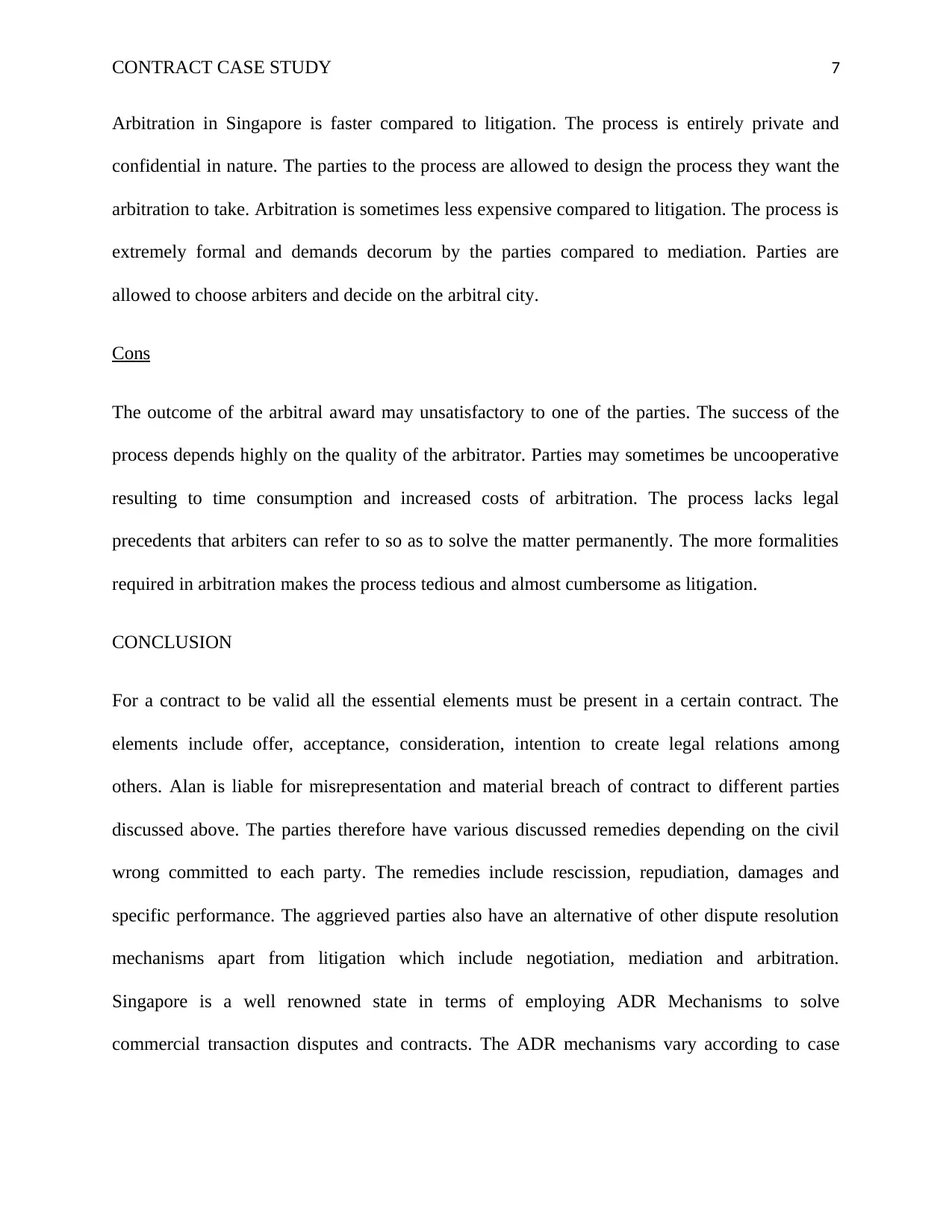
CONTRACT CASE STUDY 7
Arbitration in Singapore is faster compared to litigation. The process is entirely private and
confidential in nature. The parties to the process are allowed to design the process they want the
arbitration to take. Arbitration is sometimes less expensive compared to litigation. The process is
extremely formal and demands decorum by the parties compared to mediation. Parties are
allowed to choose arbiters and decide on the arbitral city.
Cons
The outcome of the arbitral award may unsatisfactory to one of the parties. The success of the
process depends highly on the quality of the arbitrator. Parties may sometimes be uncooperative
resulting to time consumption and increased costs of arbitration. The process lacks legal
precedents that arbiters can refer to so as to solve the matter permanently. The more formalities
required in arbitration makes the process tedious and almost cumbersome as litigation.
CONCLUSION
For a contract to be valid all the essential elements must be present in a certain contract. The
elements include offer, acceptance, consideration, intention to create legal relations among
others. Alan is liable for misrepresentation and material breach of contract to different parties
discussed above. The parties therefore have various discussed remedies depending on the civil
wrong committed to each party. The remedies include rescission, repudiation, damages and
specific performance. The aggrieved parties also have an alternative of other dispute resolution
mechanisms apart from litigation which include negotiation, mediation and arbitration.
Singapore is a well renowned state in terms of employing ADR Mechanisms to solve
commercial transaction disputes and contracts. The ADR mechanisms vary according to case
Arbitration in Singapore is faster compared to litigation. The process is entirely private and
confidential in nature. The parties to the process are allowed to design the process they want the
arbitration to take. Arbitration is sometimes less expensive compared to litigation. The process is
extremely formal and demands decorum by the parties compared to mediation. Parties are
allowed to choose arbiters and decide on the arbitral city.
Cons
The outcome of the arbitral award may unsatisfactory to one of the parties. The success of the
process depends highly on the quality of the arbitrator. Parties may sometimes be uncooperative
resulting to time consumption and increased costs of arbitration. The process lacks legal
precedents that arbiters can refer to so as to solve the matter permanently. The more formalities
required in arbitration makes the process tedious and almost cumbersome as litigation.
CONCLUSION
For a contract to be valid all the essential elements must be present in a certain contract. The
elements include offer, acceptance, consideration, intention to create legal relations among
others. Alan is liable for misrepresentation and material breach of contract to different parties
discussed above. The parties therefore have various discussed remedies depending on the civil
wrong committed to each party. The remedies include rescission, repudiation, damages and
specific performance. The aggrieved parties also have an alternative of other dispute resolution
mechanisms apart from litigation which include negotiation, mediation and arbitration.
Singapore is a well renowned state in terms of employing ADR Mechanisms to solve
commercial transaction disputes and contracts. The ADR mechanisms vary according to case
Paraphrase This Document
Need a fresh take? Get an instant paraphrase of this document with our AI Paraphraser
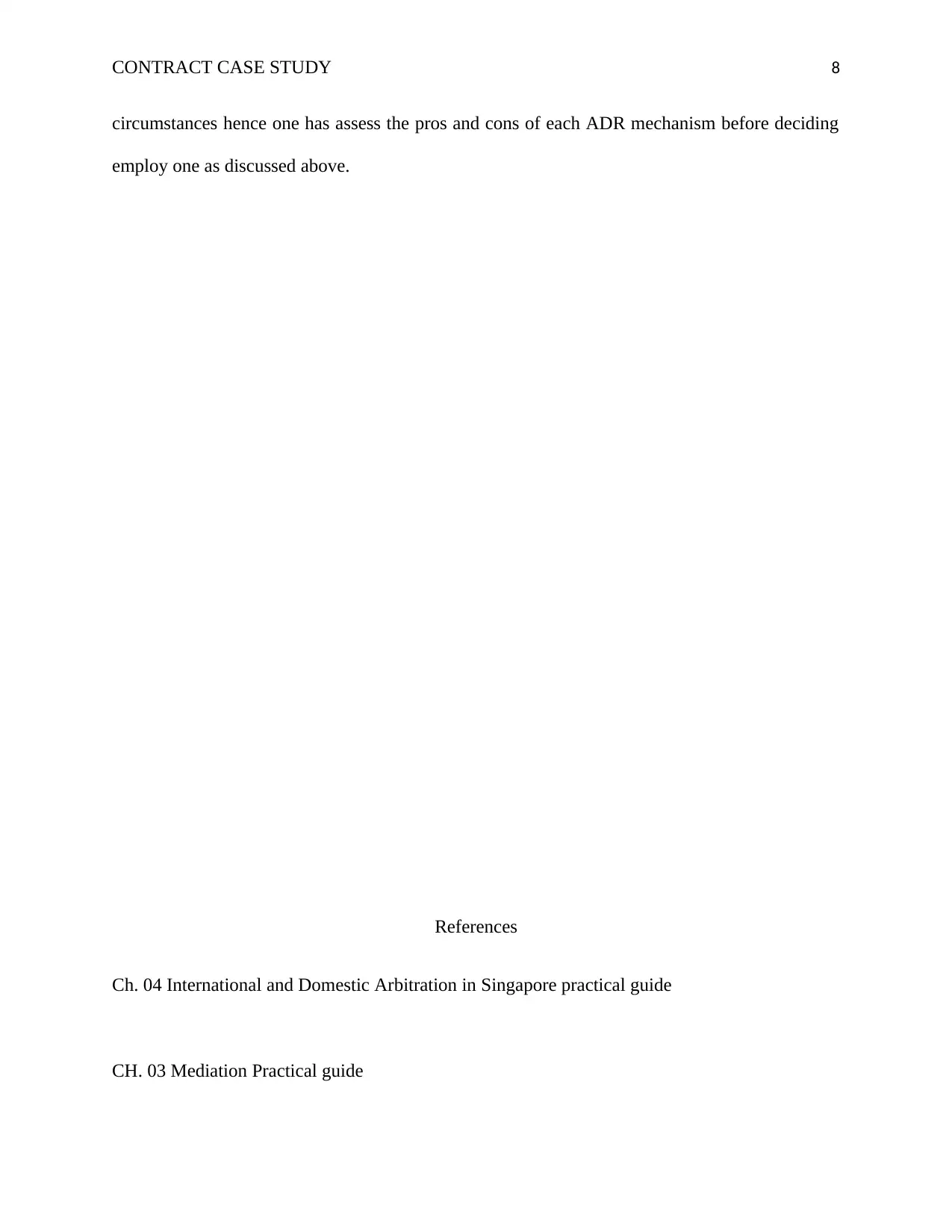
CONTRACT CASE STUDY 8
circumstances hence one has assess the pros and cons of each ADR mechanism before deciding
employ one as discussed above.
References
Ch. 04 International and Domestic Arbitration in Singapore practical guide
CH. 03 Mediation Practical guide
circumstances hence one has assess the pros and cons of each ADR mechanism before deciding
employ one as discussed above.
References
Ch. 04 International and Domestic Arbitration in Singapore practical guide
CH. 03 Mediation Practical guide
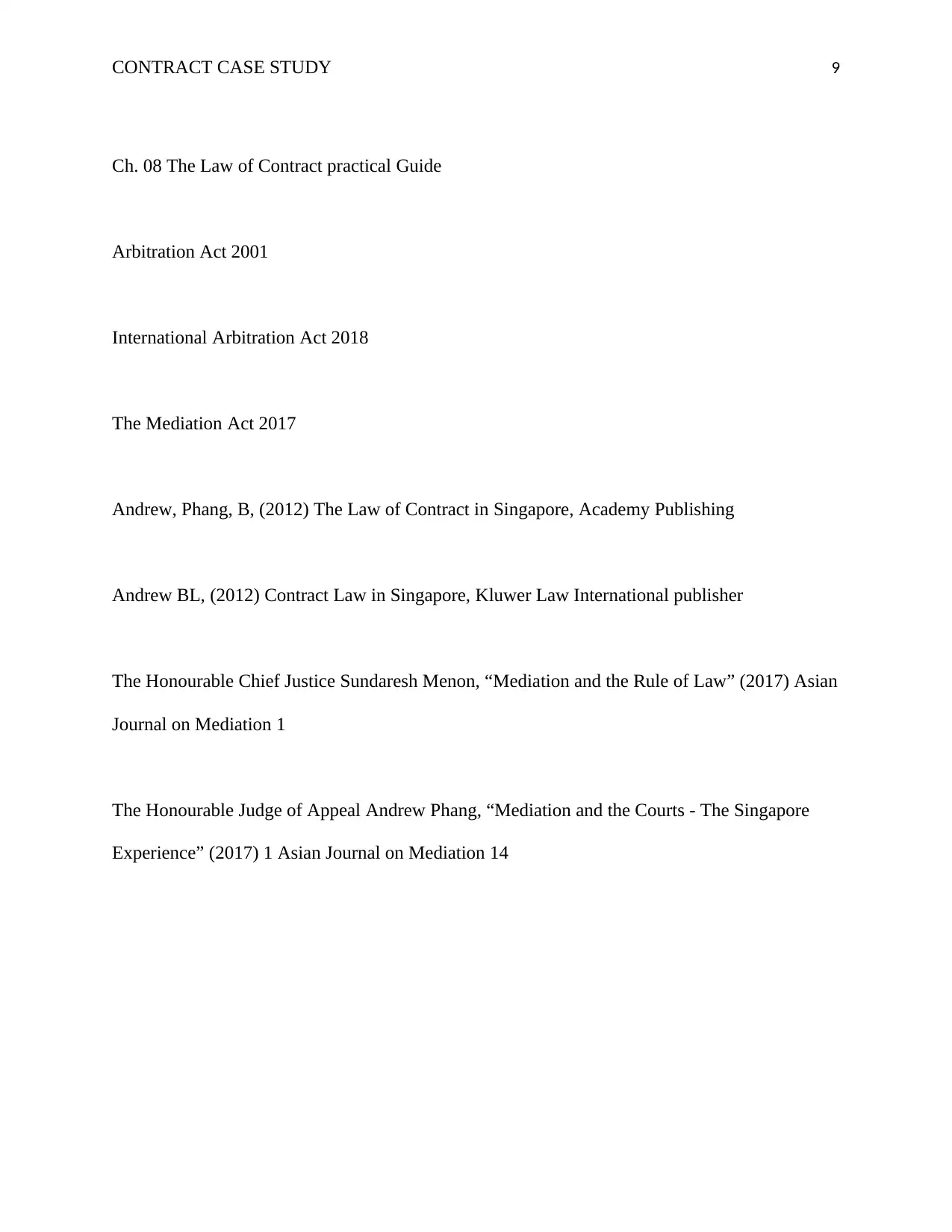
CONTRACT CASE STUDY 9
Ch. 08 The Law of Contract practical Guide
Arbitration Act 2001
International Arbitration Act 2018
The Mediation Act 2017
Andrew, Phang, B, (2012) The Law of Contract in Singapore, Academy Publishing
Andrew BL, (2012) Contract Law in Singapore, Kluwer Law International publisher
The Honourable Chief Justice Sundaresh Menon, “Mediation and the Rule of Law” (2017) Asian
Journal on Mediation 1
The Honourable Judge of Appeal Andrew Phang, “Mediation and the Courts - The Singapore
Experience” (2017) 1 Asian Journal on Mediation 14
Ch. 08 The Law of Contract practical Guide
Arbitration Act 2001
International Arbitration Act 2018
The Mediation Act 2017
Andrew, Phang, B, (2012) The Law of Contract in Singapore, Academy Publishing
Andrew BL, (2012) Contract Law in Singapore, Kluwer Law International publisher
The Honourable Chief Justice Sundaresh Menon, “Mediation and the Rule of Law” (2017) Asian
Journal on Mediation 1
The Honourable Judge of Appeal Andrew Phang, “Mediation and the Courts - The Singapore
Experience” (2017) 1 Asian Journal on Mediation 14
⊘ This is a preview!⊘
Do you want full access?
Subscribe today to unlock all pages.

Trusted by 1+ million students worldwide
1 out of 9
Related Documents
Your All-in-One AI-Powered Toolkit for Academic Success.
+13062052269
info@desklib.com
Available 24*7 on WhatsApp / Email
![[object Object]](/_next/static/media/star-bottom.7253800d.svg)
Unlock your academic potential
Copyright © 2020–2025 A2Z Services. All Rights Reserved. Developed and managed by ZUCOL.




